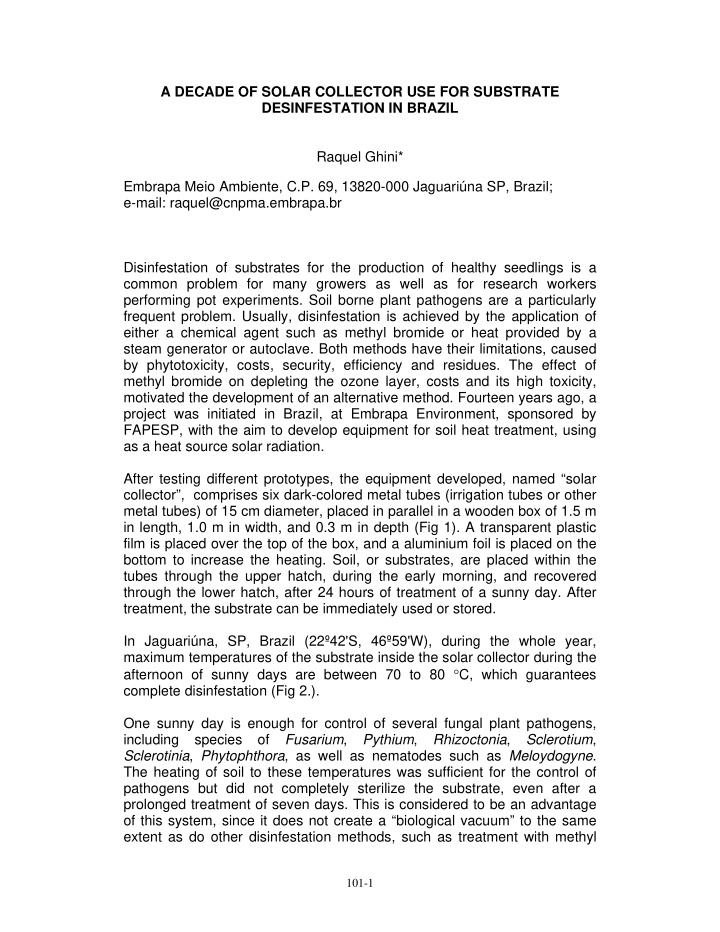



A DECADE OF SOLAR COLLECTOR USE FOR SUBSTRATE DESINFESTATION IN BRAZIL Raquel Ghini* Embrapa Meio Ambiente, C.P. 69, 13820-000 Jaguariúna SP, Brazil; e-mail: raquel@cnpma.embrapa.br Disinfestation of substrates for the production of healthy seedlings is a common problem for many growers as well as for research workers performing pot experiments. Soil borne plant pathogens are a particularly frequent problem. Usually, disinfestation is achieved by the application of either a chemical agent such as methyl bromide or heat provided by a steam generator or autoclave. Both methods have their limitations, caused by phytotoxicity, costs, security, efficiency and residues. The effect of methyl bromide on depleting the ozone layer, costs and its high toxicity, motivated the development of an alternative method. Fourteen years ago, a project was initiated in Brazil, at Embrapa Environment, sponsored by FAPESP, with the aim to develop equipment for soil heat treatment, using as a heat source solar radiation. After testing different prototypes, the equipment developed, named “solar collector”, comprises six dark-colored metal tubes (irrigation tubes or other metal tubes) of 15 cm diameter, placed in parallel in a wooden box of 1.5 m in length, 1.0 m in width, and 0.3 m in depth (Fig 1). A transparent plastic film is placed over the top of the box, and a aluminium foil is placed on the bottom to increase the heating. Soil, or substrates, are placed within the tubes through the upper hatch, during the early morning, and recovered through the lower hatch, after 24 hours of treatment of a sunny day. After treatment, the substrate can be immediately used or stored. In Jaguariúna, SP, Brazil (22º42'S, 46º59'W), during the whole year, maximum temperatures of the substrate inside the solar collector during the afternoon of sunny days are between 70 to 80 ° C, which guarantees complete disinfestation (Fig 2.). One sunny day is enough for control of several fungal plant pathogens, including species of Fusarium , Pythium , Rhizoctonia , Sclerotium , Sclerotinia , Phytophthora , as well as nematodes such as Meloydogyne . The heating of soil to these temperatures was sufficient for the control of pathogens but did not completely sterilize the substrate, even after a prolonged treatment of seven days. This is considered to be an advantage of this system, since it does not create a “biological vacuum” to the same extent as do other disinfestation methods, such as treatment with methyl 101-1
bromide, soil steaming or autoclaving. Re-infestation is more likely to occur in a soil with a “biological vacuum” because antagonistic organisms are also removed. A prolonged solar treatment of seven days also did not alter the nutrient contents of the soil. A comparative economic evaluation was performed for solar and methyl bromide soil disinfestation, based on actual cost data from a commercial nursery situated in São Bento do Sapucaí (State of São Paulo), that treats 400 m 3 of substrate a year. The yearly cost per cubic meter of substrate ranges from US$0.42 to US$0.52 in favor of methyl bromide disinfestation. However, the evaluation does not take into consideration the occupational health and environmental benefits, which greatly favor solar over chemical control. During the last ten years, many growers, nurseries and research institutions are using this equipment in instead of methyl bromide. It can be used during the whole year, over the whole country. The solar collectors offer a cheap, efficient, and safe system for the production of healthy seedlings, and it is easy to construct and operate. Fig. 1. Solar collector for substrate disinfestation. 101-2
90 80 70 Temperature (ºC) 60 50 40 30 20 10 0 00:00 02:00 04:00 06:00 08:00 10:00 12:00 14:00 16:00 18:00 20:00 22:00 Hour Fig 2. Mean temperature ( ° C) of soil mixture in solar collector (Jaguariúna, SP, Brazil; 22º42'S, 46º59'W). 101-3
Recommend
More recommend